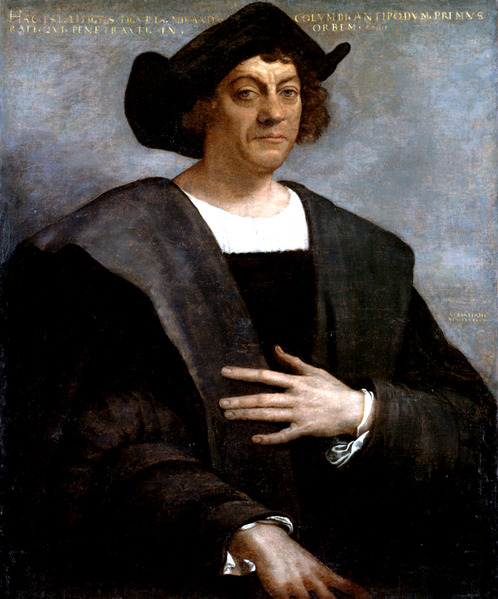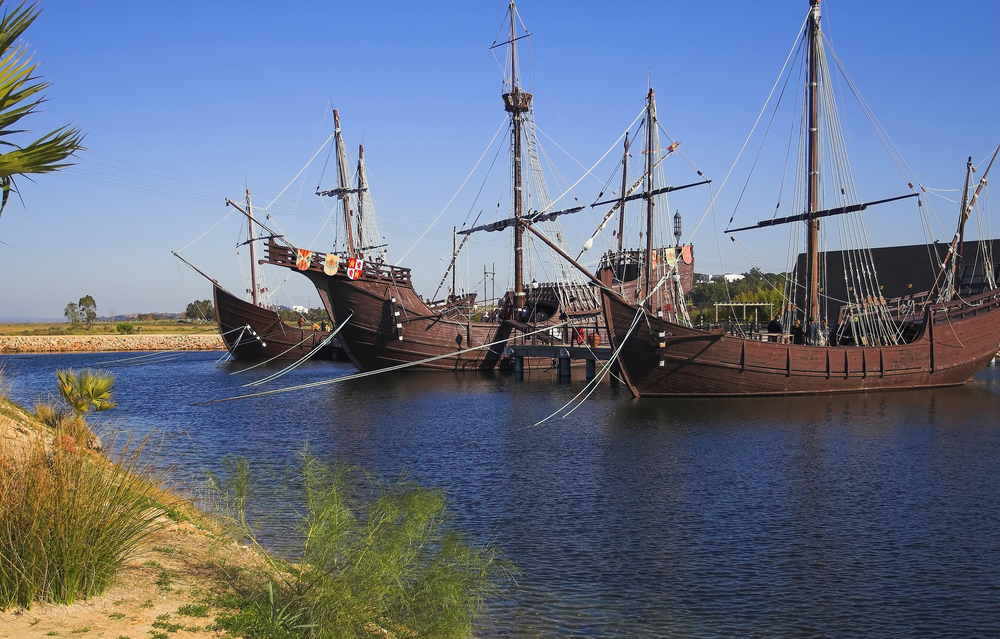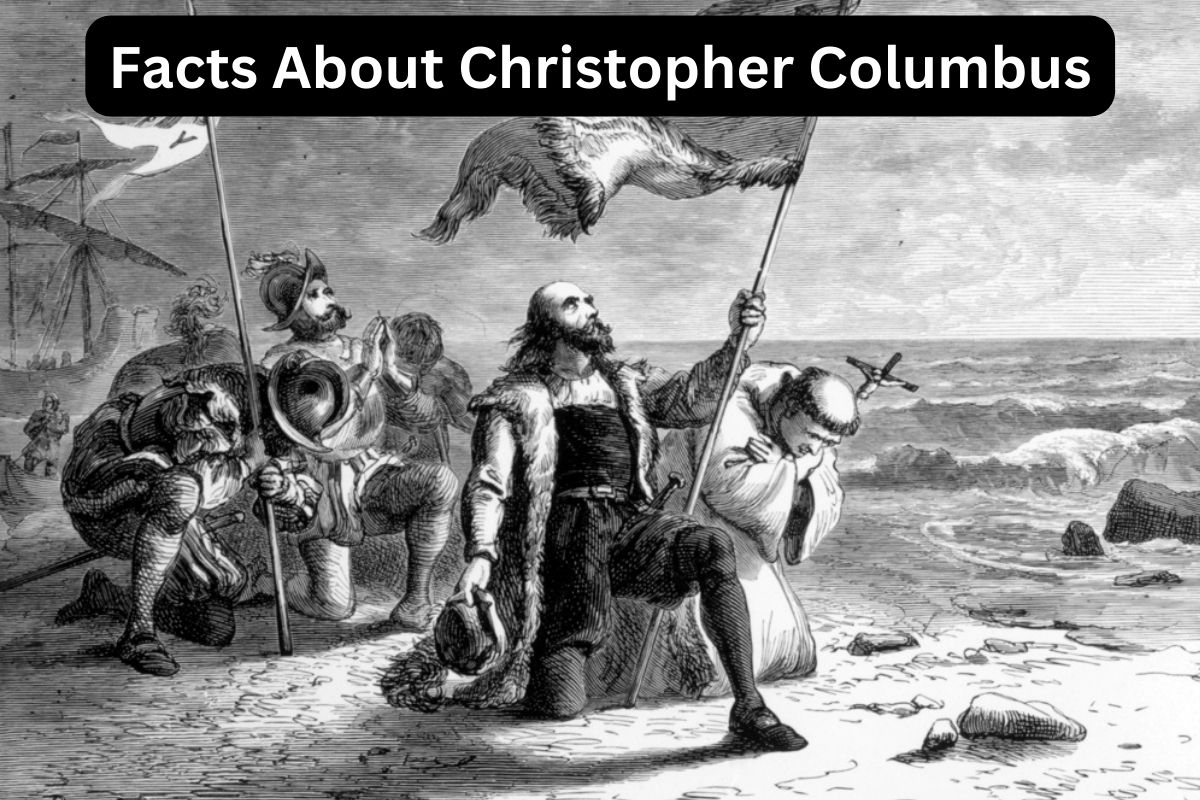Christopher Columbus was an Italian explorer who made transatlantic voyages in the late 15th century. He accidentally discovered the Americas during his search for a western route to Asia.
Columbus’s expeditions led to European exploration and colonization of the Americas, but they also resulted in the mistreatment of indigenous populations. His voyages sparked the Columbian Exchange, the exchange of plants, animals, and diseases between the Old World and the New World.
Despite controversy surrounding his actions, Columbus’s expeditions played a significant role in connecting and shaping the history of Europe and the Americas.
Christopher Columbus Facts
1. Christopher Columbus was born in 1451 in Genoa, Italy
Christopher Columbus was born in 1451 in Genoa, Italy. He came from a humble background, as his father, Domenico Colombo, was a weaver, and his mother, Susanna Fontanarossa, was a homemaker.
Also Read: Christopher Columbus Timeline
Columbus had three brothers:
- Bartolomeo
- Giovanni Pellegrino
- Giacomo

2. Columbus began his maritime career at a young age
From an early age, Columbus showed an interest in maritime activities. He received a basic education, but his true passion lay in sailing and exploration. As a teenager, he began working as a sailor on merchant ships in the Mediterranean Sea, gaining valuable experience in navigation and seafaring.
Also Read: Christopher Columbus Accomplishments
Columbus’s experience at sea provided him with a solid foundation in maritime knowledge and navigation techniques. He learned about the use of nautical instruments, such as the astrolabe and quadrant, for determining latitude and longitude.
He also studied the works of prominent geographers and scholars of the time, including Ptolemy and Marco Polo, which further fueled his desire to find a western route to Asia. Columbus believed that such a route would open up lucrative trade opportunities and expand European influence in the East.
3. In 1492, Columbus embarked on his famous voyage across the Atlantic Ocean, seeking a western route to Asia
Christopher Columbus made a total of four transatlantic voyages during his lifetime. His most famous voyage began on August 3, 1492, when he set sail from Spain with three ships:
- The Santa Maria
- The Pinta
- The Niña
Also Read: Santa Maria Ship Facts
On October 12, 1492, after several weeks at sea, Columbus and his crew made landfall in the Bahamas, specifically an island he named San Salvador. This marked the first recorded European contact with the Americas since the Vikings.

4. Columbus made a total of four transatlantic voyages during his lifetime
Columbus’s subsequent voyages further explored the Caribbean islands and the coasts of Central and South America.
On his second voyage in 1493, he founded the first European settlement in the New World, naming it Isabella, located in present-day Dominican Republic. He continued to explore various islands, including Puerto Rico and Jamaica.
5. Although Columbus is often credited with “discovering” America, there were already indigenous people living in the Americas
Although Christopher Columbus is often credited with “discovering” America, it is important to acknowledge that there were already indigenous peoples living in the Americas for thousands of years before his arrival.
Also Read: The Age of Exploration Facts
The Americas were populated by diverse indigenous cultures, each with their own languages, customs, and civilizations. These indigenous peoples had rich histories and complex societies, with advanced agricultural practices, trade networks, and sophisticated cultural achievements.
Columbus’s voyages marked the beginning of a new era of European exploration and colonization, but they did not involve the first human presence or civilization in the Americas.
6. Columbus’s voyages had a profound impact on world history
Columbus’s voyages had a significant impact on world history, leading to the colonization and exploration of the Americas by Europeans. They opened up new trade routes, facilitated the exchange of goods and cultures, and shifted the balance of power in Europe.
However, the colonization also resulted in the marginalization and mistreatment of indigenous populations, raising ongoing discussions about historical injustices.

7. Despite his significance, Columbus died in relative obscurity in 1506, and his remains were moved multiple times over the centuries
Despite his significant contributions to world history, Christopher Columbus died in relative obscurity on May 20, 1506, in Valladolid, Spain. After his death, his remains were initially buried in Valladolid but were later transferred to the monastery of La Cartuja in Seville.
However, in 1537, his remains were moved again to Santo Domingo in the Dominican Republic. Throughout history, there have been disputes and uncertainty about the exact location of his burial, with multiple claims and theories.
8. The name “America” was derived from the Latin version of the name Amerigo Vespucci
The name “America” was derived from the Latin version of the name Amerigo Vespucci, an Italian explorer who played a significant role in recognizing that Columbus’s discoveries were part of a separate continent, not Asia.
Vespucci’s accounts of his voyages to the New World, published in 1507, gained wide circulation and influenced cartographers, leading to the use of his name to label the newly discovered lands.
9. Columbus’s voyages had both positive and negative effects. On one hand, they initiated an era of European exploration and opened up new trade routes
Columbus’s voyages had both positive and negative effects. On the positive side, they initiated an era of European exploration and opened up new trade routes.
Columbus’s discoveries sparked a wave of exploration and colonization by other European powers, including Spain, Portugal, England, and France, which brought about significant advancements in navigation, trade, and cultural exchange.
10. Columbus’s arrival in the Americas had far-reaching consequences, including the Columbian Exchange
Columbus’s voyages sparked the Columbian Exchange, a term used to describe the widespread exchange of plants, animals, diseases, and ideas between the Eastern and Western Hemispheres.
This exchange had profound impacts on both sides of the Atlantic. New crops like maize, potatoes, and tomatoes were introduced to Europe, transforming agricultural practices and leading to population growth.
Similarly, European crops such as wheat, rice, and sugarcane were brought to the Americas. The exchange of diseases, however, had catastrophic effects on indigenous populations.
11. Despite popular belief, Columbus did not prove that the Earth was round
Despite popular misconceptions, Columbus did not prove that the Earth was round. By the time of his voyages, it was already widely accepted among scholars that the Earth was a sphere. However, Columbus’s navigational calculations were based on inaccurate maps and underestimated the Earth’s circumference.
He believed that by sailing westward, he would reach Asia more quickly than by traveling eastward, which turned out to be incorrect. Nonetheless, his voyages had a profound impact on maritime exploration and the understanding of global geography.
12. Columbus’s navigational calculations were based on inaccurate maps and underestimated the Earth’s circumference
Christopher Columbus’s navigational calculations were heavily influenced by the prevailing beliefs and knowledge of his time. In the late 15th century, the understanding of the Earth’s size and shape was not as accurate as it is today. Columbus relied on maps that were based on incomplete information and misconceptions about the Earth’s dimensions.
However, Columbus’s calculations were flawed due to the inaccurate maps and the underestimation of the Earth’s circumference. As a result, he mistakenly believed that he had reached the eastern coast of Asia when he arrived in the Bahamas on October 12, 1492.
This misunderstanding shaped his perception of the lands he encountered during his subsequent voyages, leading to the misnomer “West Indies” to describe the Caribbean islands and the indigenous people he encountered as “Indians.”
13. Columbus’s voyages sparked a wave of exploration and colonization by other European powers
Christopher Columbus’s voyages inspired a wave of exploration and colonization by other European powers. His discoveries motivated Spanish and Portuguese explorers to embark on their own expeditions to claim territories and establish colonies in the New World.
Spanish conquistadors, such as Hernán Cortés and Francisco Pizarro, conquered vast empires in present-day Mexico and South America, bringing significant wealth and power to their respective nations.
The Portuguese, led by explorers like Vasco da Gama and Pedro Álvares Cabral, established trading posts and colonies in Africa, Asia, and Brazil.
14. Columbus’s legacy has been reevaluated over time, and his actions have become more controversial
Columbus’s expeditions brought about significant changes in the Americas, both positive and negative. The encounter between European and indigenous cultures resulted in a complex and often tragic history.
European colonizers imposed their own systems of governance, religion, and economic structures, leading to the displacement and marginalization of indigenous peoples. Forced labor, slavery, and the destruction of indigenous civilizations were among the darker aspects of colonization.
However, the exchange of ideas, technologies, and cultures between Europe and the Americas also led to significant advancements in agriculture, medicine, and the arts.
15. Columbus’s voyages were instrumental in connecting the Eastern and Western Hemispheres
Columbus’s voyages had a lasting impact on global history. They initiated an era of increased global interconnectedness, known as the Age of Discovery or the Age of Exploration. The Columbian Exchange brought about a profound transformation of ecosystems, as plants, animals, and diseases were transferred between continents.
This exchange had long-term consequences for the development of economies, societies, and cultures worldwide. Columbus’s expeditions also challenged long-held beliefs about the size and shape of the Earth, and they paved the way for future explorers and navigators to further map and understand the world.
Today, the legacy of Columbus remains a subject of debate and scrutiny, with differing interpretations and perspectives on his significance and the consequences of his actions.
